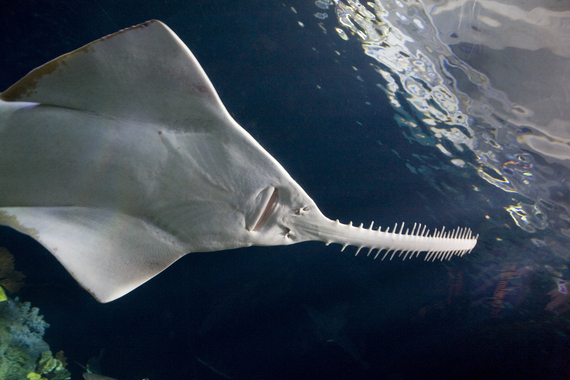This is the time of the year when most of us tend to do a lot of looking back and reflecting on the events of the past year. Which of those resolutions did we keep? What did we accomplish in our personal lives or in the workplace? I've had the opportunity to witness quite a few remarkable events of late at Shedd Aquarium, and I for one have been "wowing" and "holy cowing" quite a bit lately. Looking back for us is another reminder of what a cool place the aquarium is and how with over 32,000 patients of 1,500 or so species we never fully know what the day will bring. I'd like to share here a few examples of our extraordinary 2016.
Green Sawfish Surgery
This year the largest fish in our collection needed special attention and care. "Ginsu" is a green sawfish also known as a Longcomb sawfish who has made Shedd her home since January of 2003. If you've visited our Wild Reef exhibit chances are you've seen her swim by- - she's pretty impressive to see; 10 foot of fish and 4 foot of saw out front! Now imagine having to do surgery on her, which is exactly what we had to do. Ginsu developed a benign growth on her left rear fin. It started out fairly small but got to be larger than a hockey puck. Our first move was to confirm that it was a benign growth by doing an underwater biopsy. Our resident veterinarian-in-training got to practice clinical and diving skills simultaneously while collecting a small piece of the mass to send to the lab. Lab results confirmed our suspicions and a plan was put into place to remove the growth. Our team was challenged to get creative. The plan involved a large group of folks from different teams throughout the aquarium along with some of our medical specialist advisors. We mapped out the process of moving our biggest fish into the medical area of the Wild Reef exhibit, putting her under general anesthesia, removing the mass and placing stiches in her fin. Everything went 'swimmingly' and Ginsu has made a complete recovery. Longcomb sawfish are critically endangered in the wild and no one knows how often they may get this sort of growth. Through this creative teamwork we were able to learn more about this amazing animal and gain knowledge we can provide our colleagues in the future.

Photo credit: ©Shedd Aquarium/Brenna Hernandez
Penguin Cataract Surgery
As time goes by, the proteins that make up the lens of the eye change leading to a cloudiness we call cataracts. This is a very common condition associated with aging in almost every animal group. This year we dealt with it in one of our geriatric penguins, Rockhopper 81 (RH 81). We'd noticed cataracts in both eyes for quite some time but this year they progressed enough that they were interfering with her lifestyle. Penguins, like many birds, have a pecking order. And if you can't see very well, you can't hold your place in the pecking order. RH 81 was spending a lot of time in the corner of her habitat. With the help of a board certified veterinary ophthalmologist who usually does cataract surgery on dogs, we did cataract surgery on RH 81. This meant traveling to a specialty operating room with a surgical microscope and undergoing general anesthesia and a multi-hour surgery on each eye. After surgery RH 81 looked like a new bird! She regained much of her 'rightful place' in the flock and has returned to many of her old behaviors.
Monkey Echocardiography
In keeping with the 'you never know what the day will bring' theme, in July of this year we welcomed a new pygmy marmoset monkey into our troop named Wicket. Pygmy marmosets are one of the smallest primate species in the world. Wicket at initial weigh-in was only about 110 grams. We were surprised when we listened to his heart with a stethoscope and heard a heart murmur. A murmur doesn't necessarily mean a problem, but it does mean it needs to get checked out. The best way to check out the heart further is by doing an echocardiogram. This is a specialized systematic ultrasound examination looking at the entire pathway the blood takes through the heart. That's what we did for Wicket. We found that he has a mild case of mitral prolapse. The good news for Wicket and many with mitral prolapse is that the source of all the noise is not a problem for full function. Mitral prolapse is not uncommon and often minor. Chances are quite a few of you reading this have mitral prolapse and share something in common with our teeny, tiny monkey!
Overall, 2016 was a great year for us, as we developed new and creative ways to care for our animals. I'm looking forward to the adventures that 2017 will bring. Wishing you and your loved ones a wonderful holiday season!